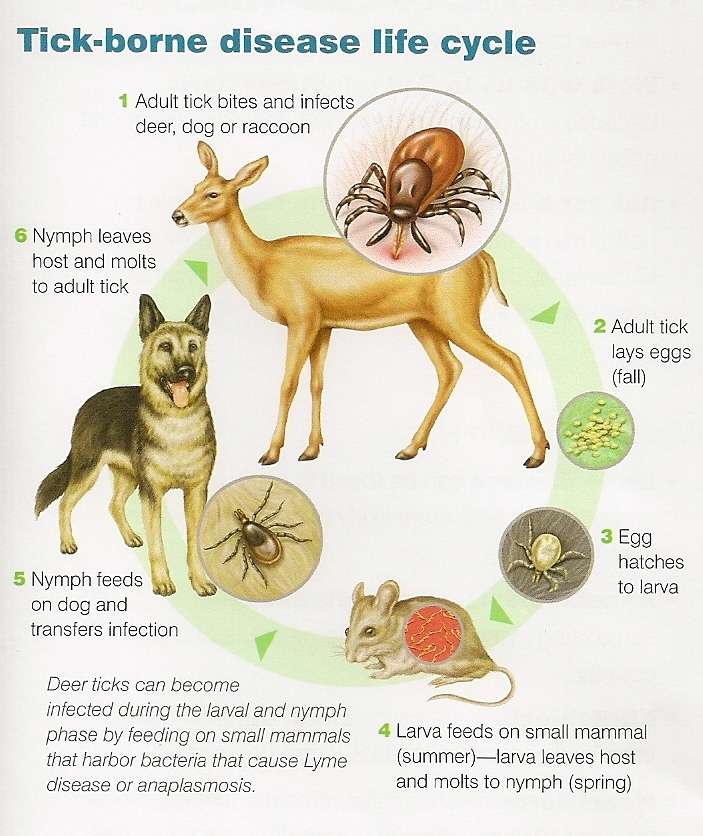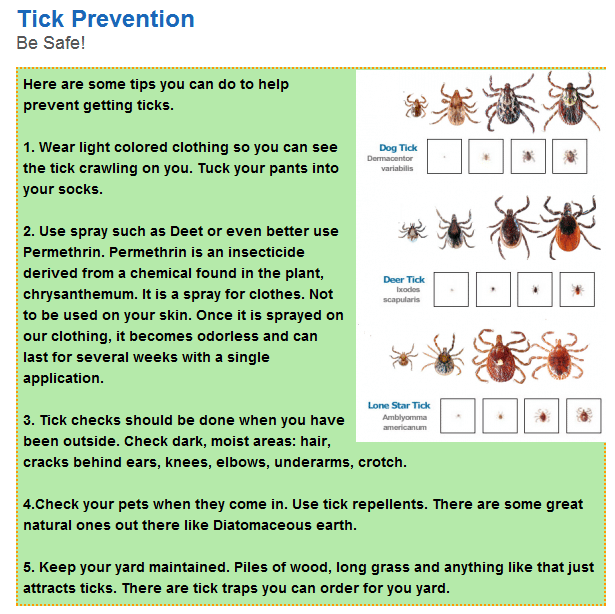Lyme Disease Prevention In Dogs
Keeping your pup on tick-prevention medication is one way of keeping them safe from contracting Lyme disease.
As well, whenever you dog has been walking through areas that may serve as a hiding spot for ticks, you should check you pets skin and remove any ticks as quickly as possible to reduce the risk of transmitting disease.
That said, removing ticks isnt as straightforward as you may think. Contact your vet for instruction on how to properly remove ticks from your dog. .
Remember Lyme disease is much more severe in humans than it is in dogs! If you walk in areas with long grass or shrubs be sure to check your skin regularly for ticks. Contact your doctor for advice on removing ticks if you find one latched onto your skin. Lyme disease in humans can cause a host of painful chronic symptoms.
Note:The advice provided in this post is intended for informational purposes and does not constitute medical advice regarding pets. For an accurate diagnosis of your pets condition, please make an appointment with your vet.
How To Prevent Dogs From Having Ticks
While it is healthy to bring your dog out often to play, keeping them indoors most of the time is still the best way to avoid ticks. After a fun walk outside, thoroughly check them for any signs of ticks or itching as the longer a tick stays attached to your dog, the higher risk of developing a disease.
Ticks attach to grass, shrubs, etc., and latch on to nearby animals so it would be best to maintain a clean environment to avoid harboring ticks.
Diagnosing And Treating Your Dog
Diagnosing your dog for Lyme disease requires the veterinarian to run an antibody test. This test takes a closer look at the bodys immunity. The response of the immune system is measurable by the test.
The experts can see whether the antibody for Lyme disease is present for making a correct diagnosis. This will show that the dogs body has been fighting the disease. If the blood reports show a high volume of antibodies then your veterinarian can make a diagnosis. Once the experts confirm the presence of the infection, they will then start the treatment.
Fortunately, the treatment of Lyme disease is straightforward and includes taking antibiotics and painkillers. Unfortunately, there is no vaccine available. Scientists continue to work on developing a vaccine to prevent Lyme disease.
Recommended Reading: Bell’s Palsy Lyme Disease Treatment
How Is Lyme Disease Diagnosed
Dogs with lameness, swollen joints, and fever are suspected of having Lyme disease. However, other diseases may also cause these symptoms. There are a few blood tests that may be used for confirmation. The first is an antibody test, that your veterinarian can perform in the clinic setting using a special test kit. This test detects the presence of antibodies created by exposure to the organism. A test can be falsely negative if the dog is infected, but has not yet formed antibodies, or if it never forms enough antibodies to cause a positive reaction. It is recommended to test no earlier than 4 weeks after a tick bite. Some dogs that have been infected for long periods of time may no longer have enough antibodies present to be detected by the test. Therefore, a positive test is meaningful, but a negative is not. A follow up test called a QC6 test can be done to assess the numerical antibody level as confirmation.
Other tests including PCR , ELISA , joint fluid analysis, and culture can also be done with varying degrees of sensitivity, but are done less commonly. General blood and urine tests are also often done to assess kidney function and look for loss of protein in the urine. See handout Testing for Lyme Disease in Dogs for further information.
Lyme Disease From Tick Larvae

Ticks arent born with Lyme Disease. They too get it from another living organism.
In the spring, ticks lay their eggs. By late summer the larvae hatch and are ready to feed. They wait on the ground for a small mammal or bird to arrive and brush up against it.
The larva will attach itself to the small animal and begin feeding over the next few days. If this animal has Lyme disease, the larva will carry the bacterium in its stomach. Mice and ground-feeding birds often serve as spirochete hosts. When the tick attaches to its next host, the bacterium transfers into the blood of the new host.
Larvae are very hard to detect as they are no larger than a period in a print magazine.
Also Check: What Are The Lasting Effects Of Lyme Disease
Keep The Dogs Breed In Mind
Similarly to the problem of misuse of antibiotics in people, there is a problem with overuse of antibiotics in animals. Ticks afflicted with Lyme disease, for example, have become more difficult to treat as a result of the widespread overuse of antibiotics in general. Veterinary professionals are well-versed in the use of antibiotics for Lyme disease in dogs when there are no clinical symptoms present but just a positive blood test results is obtained. This will be discussed in detail with you by your veterinarian.
Another course of treatment may be necessary if symptoms recur after the initial course.
Using Cbd Oil In Your Dogs Treatment Plan
There is anecdotal evidence that suggests CBD is a holistic solution that can improve your dogs overall mood and increase their appetite. The increase in appetite is important because Lyme disease in dogs can reduce their appetite. Although CBD oil is not a treatment for Lyme disease in dogs, it can help stimulate appetite and can help mitigate any pain or discomfort your dog may be feeling. If your dog has been diagnosed with Lyme disease you should speak with your trusted veterinarian to come up with a treatment plan that suits your dog.
Also Check: Lyme Bell’s Palsy Treatment
Remove The Tick Safely
The most effective method of tick removal is with a pair of tweezers or a tick remover. Wearing gloves, catch the tick around the head with sterile tweezers and pulling straight back to remove it is recommended. In order to keep the dog calm and stable, patience and assistance from a companion may be required. There may be one or several ticks on the body, and it may take some time to guarantee that they are completely removed. After removing the ticks, make careful to remove any remaining ticks.
It is preferable to remove the tick while wearing gloves and submerge it in rubbing alcohol to kill it rather than squishing it with your fingers.
What Are The Symptoms
The common clinical signs of Lyme disease in our canine companions includes acute lameness in one or multiple limbs, stiffness and an arched spine. Fever, loss of appetite and depression are also common. In rare situations heart and neurological abnormalities may take place. The kidneys may also be affected, resulting in a condition referred to as Lyme nephritis, which carries a grave prognosis and is invariably fatal. Though Lyme nephritis is also rare, Labrador Retrievers seem to be more susceptible to this manifestation of the disease. The chronic arthritis that often affects humans with Lyme disease does not seem to take place in dogs.
Also Check: Tahiti Nail Spa East Lyme
My Dog Tested Positive For Lyme Diseasenow What
The positive test means that your dog has been bitten by a tick and exposed to Lyme disease.
Exposure to Lyme disease is very different in dogs compared to exposure in people. The good news is that 90-95% of dogs exposed to Lyme disease will be perfectly fine and never develop the illness. The bad news is that your dog was bitten by a tick so we need to be sure effective tick preventatives are being used correctly, year-round. Even in winter, we have occasional mild temperatures and the ticks will be active. Most important is the fact that the ticks in your area are carrying Lyme disease, so if you find an attached engorged tick on yourself or a family member, you need to immediately contact your physician.
ln rare cases , dogs may develop a dangerous and potentially fatal kidney disease called Lyme nephritis. Technically, Lyme nephritis is a cause of protein-losing nephropathy due to immune-complex glomerulonephritis. This is the fancy way of saying the kidneys are no longer able to keep protein in the blood and the protein gets washed out into the urine. The important point is that we need to monitor alt Lyme-positive dogs, whether they are acting sick or not, by checking their urine for protein for the rest of their lives, whether treated or not, to detect this rare but potentially fatal form of Lyme disease.
They staff is all super kind and professional. They really helped make not only my pet feel better but me feel better too.
How Long Do Lyme Disease Flare Ups Last
They may last up to six months or longer. These symptoms can interfere with a persons normal activities and may cause emotional distress as a result. However, most peoples symptoms improve after six months to a year. Its not known why some people develop post-treatment Lyme disease syndrome and others dont.
Also Check: Herbs That Kill Lyme Disease
The Cause Of Lyme Disease In Dogs
Lyme disease is a bacterial infection caused by bacteria transmitted through tick bites. This disease can be caused by four main types of bacteria. These are the types of bacteria that cause Lyme disease:
- Borrelia burgdorferi
- Borrelia afzelii
- Borrelia garinii
Lyme disease is the most common tick-transmitted disease that affects both dogs and humans. Ticks transmit this disease to people and dogs when they bite them to suck their blood, allowing the infection to enter the persons bloodstream as they do so.
Lyme Disease In Dogs Can Be Serious

A dog that tests positive for Lyme disease can be easily treated, but the damage that occurs before diagnosis occurs is preventable if you can keep your dog from being bitten by ticks to begin with. Between checking them after walking in risky areas to keeping a tick deterrent on them, there are plenty of methods for making sure Lyme-infected ticks stay off your furry friend.
Recommended Reading: Can Lyme Disease Cause A Stroke
Lyme Disease: What Dog Lovers Need To Know
You probably know Lyme Disease is carried by ticks. Those nasty little parasites look for a warm body to attach to and feed on. Some of those ticks are infected with the bacteria that cause Lyme disease Borrelia Burgdorferi.
However, you might not know that your dog can test positive for Lyme disease and not actually have it. Strange, right? But its true. According to Tufts University Cummings School of Veterinary Medicine, testing positive simply means your pet tested positive for the antibodies but only about 5% of dogs actually develop the illness.
Thats good news for dog lovers!
Yet, you should be aware of the symptoms of Lyme Disease in dogs just in case your pet is one of that 5 %. Its also a good idea to discuss the pros and cons of the Lyme vaccine youre your veterinarian.
The other thing youll want to know is that some dogs will show fever and lameness within 2-3 days and with othersâ¦it can take MONTHS before your dog shows any signs. In other words, you can pick 10 ticks off your dog in August and it can be Halloween before your dog starts showing signs of the illness. If you find ticks and your dog shows any signs of lethargy or lameness, go to vet immediately. Acute forms of Lyme are much easier to treat.
Recommended Reading: Will Lyme Disease Go Away
Is Treatment 100% Effective
Scientists are divided on this topic. Some studies suggest that that even long-term antibiotics may not completely clear infection dogs may get sick again at some point after antibiotic treatment is stopped. Other studies suggest that complete clearance of infection is possible with antibiotic treatment. Further research is required to answer this question.
Also Check: Herbs That Kill Lyme Disease
Also Check: Antibiotics Used To Treat Lyme Disease
If My Animal Is Positive On The Assay Should He/she Be Treated For Lyme Disease
If your animal is displaying clinical signs of Lyme disease and is positive on the Lyme Multiplex assay, it is advisable to discuss treatment options with your veterinarian. If your animal appears healthy, discuss the risks and benefits of treatment and develop a monitoring plan with your veterinarian.
How Do Vets Test For Lyme Disease
Vets typically test for Lyme disease using a series of bloodwork known as the SNAP test. These blood tests also test for heartworms, ehrlichiosis, and anaplasmosis. The cost of this blood work varies widely from veterinarian to veterinarian, so be sure to discuss the costs before you agree to run any tests.
Also Check: Lyme Disease And Multiple Sclerosis
Do Dogs Get Lyme Disease
Lyme disease is a bacterial infection of increasing public health importance worldwide. The bug in question is Borrelia burgdorferi, which is transmitted through the bite of the sheep tick, Ixodes Ricinus. Lyme disease in people causes flu-like symptoms and a characteristic rash , usually several weeks after the tick bite. About 10% of patients1 , however, can go on to develop serious neurological complications1.
Ticks are present throughout the British Isles, although hotspots can be found in the Scottish Highlands, the South East and the South West of the UK. They thrive in rough grassy heathland and woods, particularly in areas where there are deer. Although Ixodes can also be found in urban areas. Ticks are most active in the summer when they go questing for their next meal, and about 5 to 10% of ticks carry the Borrelia bacterium2.
There are precautions you can take before heading out on that day-long hike in the countryside, COVID restrictions allowing, to prevent from yourself getting bitten. But have you thought if you should be protecting your dog as well?
How To Prevent Lyme Disease
People with pets should:
- Use reliable tick-preventive products. Speak with your veterinarian about what tick preventive product is right for your pet.
- Work with your veterinarian to decide whether to vaccinate your dog against Lyme disease. Your veterinarians advice may depend on where you live, your pet’s lifestyle and overall health, and other factors.
- When possible, avoid areas where ticks might be found. These include tall grasses, marshes and wooded areas.
- Check for ticks on both yourself and your animals once indoors.
- Clear shrubbery next to homes.
- Keep lawns well maintained.
As noted above, there are preventive Lyme disease vaccines available for dogs, but they aren’t necessarily recommended for every dog. Consult your veterinarian to see if the vaccination makes sense for your pets. If your veterinarian does recommend that your dog be vaccinated against Lyme disease, the typical protocol will involve an initial vaccination followed by a booster 2-4 weeks later and annual boosters after that.
You May Like: Do Antibiotics Cure Lyme Disease
Prevent Lyme Disease In Your Dog
The Honorable Dr. Rau. The results of Dr Raus investigation revealed that all of the patients who progressed to Stage 3 had imbalanced fatty acid profiles, according to him. Not surprisingly, this is true. Because low omega-3 levels induce an imbalance, inflammation can occur, which is one of the several cofactors mentioned above.
- The Honorable Dr. Rau The results of Dr Raus investigation also revealed that all of the patients who progressed to Stage 3 had imbalanced fatty acid profiles. This is hardly a surprise. Because low omega-3 levels induce an imbalance, inflammation can occur, which is one of the several cofactors described above.
Furthermore, the negative impacts of traditional remedies such as.
Treatment Of Lyme Disease In Dogs

Treatment for Lyme disease relies on the use of antibiotics to kill the Borrelia burgdorferi bacterium. Antibiotics are generally prescribed for 4 weeks. Many symptoms of pain and joint issues will often subside within the first 3 to 5 days of treatment, but if they don’t, a second antibiotic may be administered. For some dogs, a second round of treatment may also be needed to completely eradicate the bacteria.
Successful treatment also depends on how early Lyme disease was diagnosed, as the longer the bacteria has to filter through the body, the more it can affect. Additional therapies may be prescribed to treat the kidneys, heart or nervous system as needed. In some cases, your veterinarian may also prescribe pain medication to help with the generalized pain in your dog’s joints.
For many dogs, Lyme disease can be successfully treated with a diligent course of antibiotic treatment, but for some animals, symptoms may linger after treatment and may require additional therapies.
Worried about the cost of Lyme Disease treatment?
Pet Insurance covers the cost of many common pet health conditions. Prepare for the unexpected by getting a quote from top pet insurance providers.
Don’t Miss: Dog Lyme Disease Treatment Cost
Is There A Vaccine That Will Protect My Dog From Lyme Disease
A safe and generally effective vaccine is available for protecting dogs against Lyme disease. This vaccine is initially given twice, at two- to four-week intervals.
“Annual revaccination is necessary to maintain immunity.”
Annual revaccination is necessary to maintain immunity. Vaccination against Lyme disease will be determined by your pet’s lifestyle and individual risk assessment. Be sure to discuss any questions you may have regarding the type and frequency of vaccination with your veterinarian.
| Contributors: Ryan Llera, BSc, DVM Ernest Ward, DVM |